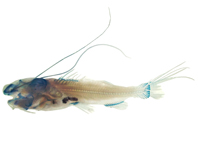Abstract
Based on biological, morphological, distributional and genomic data, it is concluded that the malvid-associated Baris albosparsa (Faust), Malvaevora timida (Rossi) and Squamobaris aurea Pajni, Kohli & Kumar are monophyletic and distinct from Baris Germar. Squamobaris Pajni, Kohli & Kumar is synonymized with Malvaevora Zaslavskij (new synonymy). Baris albosparsa and S. aurea are transferred to Malvaevora (new combinations). Baris timida polita Reitter, B. subtilina Reitter, Baridius landgrebii Hochhuth and Baridius striatopunctatus Gistel are synonymized with M. timida and Baris striatopunctata Reitter is synonymized with Melanobaris carbonaria (Boheman) (new synonymies). Lectotypes are designated for B. timida polita and B. landgrebii. Baris striolala Aurivillius is recorded from China for the first time.
References
Behne, L. (1991) Die Typen der von Johann Heinrich Hochhuth beschriebenen Curculionidae-Arten in der Sammlung des Deutschen Entomologischen Instituts. Beiträge zur Entomologie, 41, 401–404.
Dejean, P.F.M.A. (1835) s.n. In: Catalogue de Coléoptères de la collection de M. le Comte Dejean. 2nd Édition. Quatrième Livraison. Méquignon-Marvis, Paris, pp. 257–360.
Haran, J., Timmerman, M.J.T.N. & Vogler, A.P. (2013) Mitogenome sequences stabilize the phylogenetics of weevils (Curculionoidea) and establish the monophyly of larval ectophagy. Molecular Phylogenetics and Evolution, 67, 156–166.
https://doi.org/10.1016/j.ympev.2012.12.022
Korotyaev, B.A., Ismailova, M. Sh., Garzanov, Y.G., Davidian, G.E. & Prasolov, V.N. (1993) Vesennyaya fauna zhukov-dolgonosikov (Coleoptera: Apionidae, Rhynchophoridae, Curculionidae) nizmennogo i predgornogo Dagestana. Entomologicheskoe obozrenje, 72, 836–865.
Pajni, H.R. (1989) Studies on morphotaxonomy and cytotaxonomy of the Indian Curculionidae along with the ecology of the pest species. Final Technical Report (1984–89) to USDA-ARS, 1989, 1–80.
Pajni, H.R., Kohli, S.K. & Kumar, D. (1990) On a new genus and a new species of Baridinae from India (Coleoptera: Curculionidae: Baridinae). Hexapoda (Insecta Indica), 2, 91–94.
Pelley, R.H. le (1959) Agricultural insects of East Africa. East Africa High Commission, Nairobi, Kenya, x + 307 pp.
Ronquist, F., Teslenko, M., van der Mark, P., Ayres, D., Darling, A., Höhna, S., Larget, B., Liu, L., Suchard, M.A. & Huelsenbeck, J.P. (2012) MrBayes 3.2: Efficient Bayesian phylogenetic inference and model choice across a large model space. Systematic Biology, 61, 539–542.
https://doi.org/10.1093/sysbio/sys029
Shorthouse, D. P. (2010) SimpleMappr, an online tool to produce publication-quality point maps. Available from: https://www.simplemappr.net (accessed 7 April 2020)
Simon, C., Frati, F., Beckenbach, A., Crespi, B., Liu, H. & Flook, P. (1994) Evolution, weighting, and phylogenetic utility of mitochondrial gene sequences and a compilation of conserved polymerase chain reaction primers. Annals of the Entomological Society of America, 87, 651–701.
https://doi.org/10.1093/aesa/87.6.651
Zaslavskij, V.A. (1956) Revizija dolgonosikov roda Baris Germ. fauny Sovetskogo Sojuza i sopredelnykh stran. Trudy Vsesojuznogo ëntomologicheskogo obshchestva, 45, 343–377.


